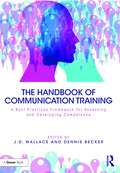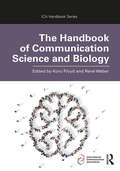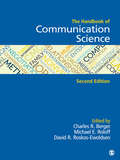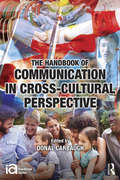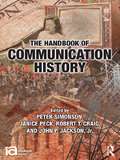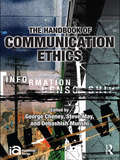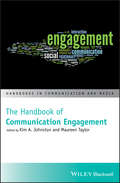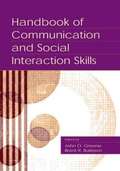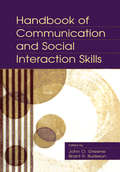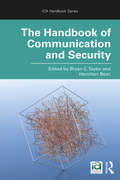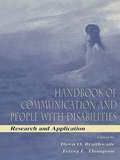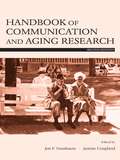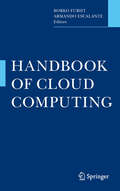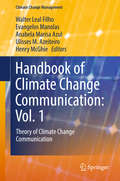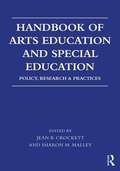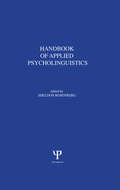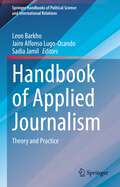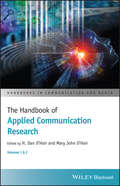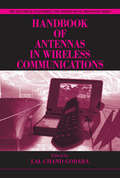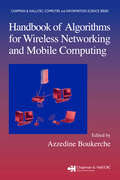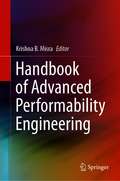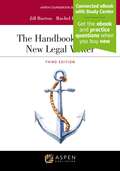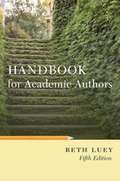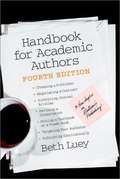- Table View
- List View
The Handbook of Communication Training: A Best Practices Framework for Assessing and Developing Competence
by J D Wallace Dennis BeckerCommunication remains a significant topic for job acquisition, development, and advancement. As such, there are no shortage of classes, seminars and books written on the subject. However, there are few designed for the corporate consultant that are not aligned with some proprietary system, traditional academic classrooms, or author’s speculation. These tend to be either inaccessible, questionable in their content, or specifically aligned with the producers’ interests. So where can the Communication trainers and consultants go to focus on fundamental touchstone research and practices? The Handbook of Communication Training is a powerful template, and first of its kind, for communication practitioners and academicians who wish to strengthen their professional capabilities. It also acts as a guide and standard for consumers and clients of these services. The chapters within are an outgrowth of the National Communication Association’s Training & Development Division’s desire to provide guidance, structure, and support for members and non-members alike. It is specifically targeted at those pursuing best practices regarding communication consulting, coaching, teaching and training. The 7 Best Practices presented in this book represent capabilities that are foundational to the effective transfer of communication promotion and skill enhancement. As such, these practices, and supporting chapters, should appeal to novice and experts alike.
The Handbook of Communication Science and Biology (ICA Handbook Series)
by Kory Floyd René WeberThe Handbook of Communication Science and Biology charts the state of the art in the field, describing relevant areas of communication studies where a biological approach has been successfully applied. The book synthesizes theoretical and empirical development in this area thus far and proposes a roadmap for future research. As the biological approach to understanding communication has grown, one challenge has been the separate evolution of research focused on media use and effects and research focused on interpersonal and organizational communication, often with little intellectual conversation between the two areas. The Handbook of Communication Science and Biology is the only book to bridge the gap between media studies and human communication, spurring new work in both areas of focus. With contributions from the field’s foremost scholars around the globe, this unique book serves as a seminal resource for the training of the current and next generation of communication scientists, and will be of particular interest to media and psychology scholars as well.
The Handbook of Communication Science
by Charles R. Berger Michael E. Roloff David R. EwoldsenThis revision of a classic volume presents state-of-the-art reviews of established and emerging areas of communication science and provides an intellectual compass that points the way to future theorizing about communication processes. In this Second Edition of The Handbook of Communication Science, editors Charles R. Berger, Michael E. Roloff, and David Roskos-Ewoldsen bring together an impressive array of communication scholars to explore and synthesize the varying perspectives and approaches within the dynamic field of communication science. After first addressing the methods of research and the history of the field, the Handbook then examines the levels of analysis in communication (individual to macro-social), the functions of communication (such as socialization and persuasion), and the contexts in which communication occurs (such as couples, families, organizations, and mass media). Key Features: Draws on the scholarship and expertise of leading communication scholars who explore different aspects of the field Covers all facets of communication science, from the historical and theoretical to the practical and applied Covers the latest theoretical developments in the field, as well as alternative methodologies and levels of analysis Explores key communication contexts of the 21st century, including interpersonal dimensions of health communication, the scientific investigation of marital and family communication, and computer-mediated communication Includes incisive analyses, literature reviews, bibliographies, and suggestions for future research The Handbook of Communication Science, Second Edition, is an essential reference resource for scholars, practitioners, and students. It is appropriate for upper-level undergraduate or graduate courses in Communication and Media Studies and Mass Communication.
The Handbook of Communication in Cross-cultural Perspective (ICA Handbook Series)
by Donal CarbaughThis handbook brings together 26 ethnographic research reports from around the world about communication. The studies explore 13 languages from 17 countries across 6 continents. Together, the studies examine, through cultural analyses, communication practices in cross-cultural perspective. In doing so, and as a global community of scholars, the studies explore the diversity in ways communication is understood around the world, examine specific cultural traditions in the study of communication, and thus inform readers about the range of ways communication is understood around the world. Some of the communication practices explored include complaining, hate speech, irreverence, respect, and uses of the mobile phone. The focus of the handbook, however, is dual in that it brings into view both communication as an academic discipline and its use to unveil culturally situated practices. By attending to communication in these ways, as a discipline and a specific practice, the handbook is focused on, and will be an authoritative resource for understanding communication in cross-cultural perspective. Designed at the nexus of various intellectual traditions such as the ethnography of communication, linguistic ethnography, and cultural approaches to discourse, the handbook employs, then, a general approach which, when used, understands communication in its particular cultural scenes and communities.
The Handbook of Communication History (ICA Handbook Series)
by Jr. Janice Peck Peter Simonson Robert T. Craig John P. JacksonThe Handbook of Communication History addresses central ideas, social practices, and media of communication as they have developed across time, cultures, and world geographical regions. It attends to both the varieties of communication in world history and the historical investigation of those forms in communication and media studies. The Handbook editors view communication as encompassing patterns, processes, and performances of social interaction, symbolic production, material exchange, institutional formation, social praxis, and discourse. As such, the history of communication cuts across social, cultural, intellectual, political, technological, institutional, and economic history. The volume examines the history of communication history; the history of ideas of communication; the history of communication media; and the history of the field of communication. Readers will explore the history of the object under consideration (relevant practices, media, and ideas), review its manifestations in different regions and cultures (comparative dimensions), and orient toward current thinking and historical research on the topic (current state of the field). As a whole, the volume gathers disparate strands of communication history into one volume, offering an accessible and panoramic view of the development of communication over time and geographical places, and providing a catalyst to further work in communication history.
The Handbook of Communication Ethics (ICA Handbook Series)
by George CheneyThe Handbook of Communication Ethics serves as a comprehensive guide to the study of communication and ethics. It brings together analyses and applications based on recognized ethical theories as well as those outside the traditional domain of ethics but which engage important questions of power, equality, and justice. The work herein encourages readers to make important connections between matters of social justice and ethical theory. This volume makes an unparalleled contribution to the literature of communication studies, through consolidating knowledge about the multiple relationships between communication and ethics; by systematically treating areas of application; and by introducing explicit and implicit examinations of communication ethics to one another. The Handbook takes an international approach, analyzing diverse cultural contexts and comparative assessments. The chapters in this volume cover a wide range of theoretical perspectives on communication and ethics, including feminist, postmodern and postcolonial; engage with communication contexts such as interpersonal and small group communication, journalism, new media, visual communication, public relations, and marketing; and explore contemporary issues such as democracy, religion, secularism, the environment, trade, law, and economics. The chapters also consider the dialectical tensions between theory and practice; academic and popular discourses; universalism and particularism; the global and the local; and rationality and emotion. An invaluable resource for scholars in communication and related disciplines, the Handbook also serves as a main point of reference in graduate and upper-division undergraduate courses in communication and ethics. It stands as an exceptionally comprehensive resource for the study of communication and ethics.
The Handbook of Communication Engagement (Handbooks in Communication and Media)
by Kim A. Johnston Maureen TaylorA comprehensive volume that offers the most current thinking on the practice and theory of engagement With contributions from an international panel of leaders representing diverse academic and professional fields The Handbook of Communication Engagement brings together in one volume writings on both the theory and practice of engagement in today’s organizations and societies. The expert contributors explore the philosophical, theoretical, and applied concepts of communication engagement as it pertains to building interaction and connections in a globalized, networked society. The Handbook of Communication Engagement is comprehensive in scope with case studies of engagement from various disciplines including public relations, marketing, advertising, employee relations, education, public diplomacy, and politics. The authors advance the current thinking in engagement theory, strategy, and practice and provide a review of foundational and emerging research in engagement topics. The Handbook of Communication Engagement is an important text that: Provides an overview of the foundations and philosophies of engagement Identifies the contexts of engagement relating to specific areas across government and corporations, including CSR, consumer, activism, diplomacy, digital, and social impact Includes examples of contemporary engagement practice Presents applications of engagement and technology Offers insights on the future directions of engagement The Handbook of Communication Engagement offers an essential reference for advanced undergraduate, graduate students, practitioners and scholars from communication, media, advertising, public relations, public policy, and public diplomacy areas. The volume contains a compendium of the writings on the most recent advances on the theory and practice of engagement. Winner of the 2018 PRIDE Award for Innovation, Development, and Educational Achievement from the Public Relations Division of the National Communication Association.
Handbook of Communication and Social Interaction Skills
by John O. Greene Brant Raney BurlesonProviding a survey of the theory and research on social interaction skills, this volume contains 24 papers on theoretical and methodological concerns in research, fundamental interaction skills, function-focused skills, the management of diverse personal relationships, and the sills required by public and professional life. Specific chapters discuss models of skill acquisition, methods of assessment, persuasion, friendship, marriage, management, leadership, and teaching. Empirically supported strategies for developing and enhancing these skills are emphasized. Annotation (c)2003 Book News, Inc., Portland, OR (booknews.com)
Handbook of Communication and Social Interaction Skills (Routledge Communication Series)
by JOHN O. GREENE; BRANT R. BURLESONProviding a thorough review and synthesis of work on communication skills and skill enhancement, this Handbook serves as a comprehensive and contemporary survey of theory and research on social interaction skills. Editors John O. Greene and Brant R. Burleson have brought together preeminent researchers and writers to contribute to this volume, establishing a foundation on which future study and research will build. The handbook chapters are organized into five major units: general theoretical and methodological issues (models of skill acquisition, methods of skill assessment); fundamental interaction skills (both transfunctional and transcontextual); function-focused skills (informing, persuading, supporting); skills used in management of diverse personal relationships (friendships, romances, marriages); and skills used in varied venues of public and professional life (managing leading, teaching). Distinctive features of this handbook include:* broad, comprehensive treatment of work on social interaction skills and skill acquisition;* up-to-date reviews of research in each area; and* emphasis on empirically supported strategies for developing and enhancing specific skills.Researchers in communication studies, psychology, family studies, business management, and related areas will find this volume a comprehensive, authoritative source on communications skills and their enhancement, and it will be essential reading for scholars and students across the spectrum of disciplines studying social interaction.
The Handbook of Communication and Security (ICA Handbook Series)
by Bryan C. Taylor Hamilton BeanThe Handbook of Communication and Security provides a comprehensive collection and synthesis of communication scholarship that engages security at multiple levels, including theoretical vs. practical, international vs. domestic, and public vs. private. The handbook includes chapters that leverage communication-based concepts and theories to illuminate and influence contemporary security conditions. Collectively, these chapters foreground and analyze the role of communication in shaping the economic, technological, and cultural contexts of security in the 21st century. This book is ideal for advanced undergraduate and postgraduate students and scholars in the numerous subfields of communication and security studies.
Handbook of Communication and People With Disabilities: Research and Application (Routledge Communication Series)
by Dawn O. Braithwaite Teresa L. ThompsonThis Handbook represents the first comprehensive collection of research on communication and people with disabilities. The editors have brought together original contributions focusing on the identity, social, and relationship adjustments faced by people with disabilities and those with whom they relate. Essays report on topics across the communication spectrum--interpersonal and relationship issues, people with disabilities in organizational settings, disability and culture, media and technologies, communication issues as they impact specific types of disabilities--and establish a future agenda for communication and disability research. Each chapter provides a state-of-the-art literature review, practical applications of the material, and keywords and discussion questions to facilitate classroom use. In providing an outlet for current research on communication and disability issues, this unique collection contributes to the lives of people with and without disabilities, helping them to improve their own communication and relationships. Intended for readers in communication, psychology, sociology, rehabilitation, social work, special education, gerontology, and related disciplines, this handbook is certain to augment further theory and research, as well as offer insights for both personal and professional relationships.
Handbook of Communication and Aging Research
by Jon F. Nussbaum Justine CouplandThis second edition of the Handbook of Communication and Aging Research captures the ever-changing and expanding domain of aging research. Since it was first recognized that there is more to social aging than demography, gerontology has needed a communication perspective. Like the first edition, this handbook sets out to demonstrate that aging is not only an individual process but an interactive one. The study of communication can lead to an understanding of what it means to grow old. We may age physiologically and chronologically, but our social aging--how we behave as social actors toward others, and even how we align ourselves with or come to understand the signs of difference or change as we age--are phenomena achieved primarily through communication experiences.Synthesizing the vast amount of research that has been published on communication and aging in numerous international outlets over the last three decades, the book's contributors include scholars from North America and the United Kingdom who are active researchers in the perspectives covered in their particular chapter. Many of the chapters work to deny earlier images of aging as involving normative decrement to provide a picture of aging as a process of development involving positive choices and providing new opportunities. A recuring theme in many chapters is that of the heterogeneity of the group of people who are variously categorized as older, aged, elderly, or over 65. The contributors review the literature analytically, in a way that reveals not only current theoretical and methodological approaches to communication and aging research but also sets the future agenda.This handbook will be of great interest to scholars and researchers in gerontology, developmental psychology, and communication, and, in this updated edition, will continue to play a key role in the study of communication and aging.
Handbook of Cloud Computing
by Borko Furht Armando EscalanteCloud computing has become a significant technology trend. Experts believe cloud computing is currently reshaping information technology and the IT marketplace. The advantages of using cloud computing include cost savings, speed to market, access to greater computing resources, high availability, and scalability. Handbook of Cloud Computing includes contributions from world experts in the field of cloud computing from academia, research laboratories and private industry. This book presents the systems, tools, and services of the leading providers of cloud computing; including Google, Yahoo, Amazon, IBM, and Microsoft. The basic concepts of cloud computing and cloud computing applications are also introduced. Current and future technologies applied in cloud computing are also discussed. Case studies, examples, and exercises are provided throughout. Handbook of Cloud Computing is intended for advanced-level students and researchers in computer science and electrical engineering as a reference book. This handbook is also beneficial to computer and system infrastructure designers, developers, business managers, entrepreneurs and investors within the cloud computing related industry.
Handbook of Climate Change Communication: Vol. 1
by Walter Leal Filho Evangelos Manolas Anabela Marisa Azul Ulisses M. Azeiteiro Henry McGhieThis comprehensive handbook provides a unique overview of the theory, methodologies and best practices in climate change communication from around the world. It fosters the exchange of information, ideas and experience gained in the execution of successful projects and initiatives, and discusses novel methodological approaches aimed at promoting a better understanding of climate change adaptation. Addressing a gap in the literature on climate change communication and pursuing an integrated approach, the handbook documents and disseminates the wealth of experience currently available in this field. Volume 1 of the handbook provides a unique description of the theoretical basis and of some of the key facts and phenomena which help in achieving a better understanding of the basis of climate change communication, providing an essential basis for successful initiatives in this complex field.
Handbook of Arts Education and Special Education: Policy, Research, and Practices
by Jean B. Crockett Sharon M. MalleyThe Handbook of Arts Education and Special Education brings together, for the first time in a single reference volume, policy, research, and practices in special education and arts education synthesized to inform stakeholders across a broad spectrum of education. This handbook encompasses arts education for students with disabilities, from pre-K through transition to postsecondary education and careers as well as community arts education, with particular attention to conceptual foundations; research-based practices; professional standards; students’ cognitive, artistic, and social growth; career education; and future directions for research and practice in special education and arts education.
Handbook of Applied Psycholinguistics: Major Thrusts of Research and Theory
by Sheldon RosenbergFirst published in 1982. The chapters of this handbook contain critical integrative reviews of research and theory in the major areas of the field of applied psycholinguistics, the field in which applied problems of language and communicative functioning and development are approached from the standpoint of basic research and theory in psycholinguistics and related areas of cognitive psychology. The book was designed to meet the needs of researchers, practitioners and graduate students from such disciplines as education (including special education), language learning, linguistics, neurology, psychiatry, psychology, and speech and hearing for such reviews, although the state of research in an area and a desire to stress research and theory in substantive areas resulted in a decision not to include chapters on the measurement of linguistic maturity, language intervention, the language of the learning disabled child, language and environmental deprivation, language and mania, language and senile dementia, and the design of written and oral information and computer command language.
Handbook of Applied Journalism: Theory and Practice (Springer Handbooks of Political Science and International Relations)
by Leon Barkho Jairo Alfonso Lugo-Ocando Sadia JamilThis authoritative handbook looks at the entire news cycle and provides a bridge between the theoretical and academic study of journalism and its actual contemporary practice. The book's main merit is that it brings theory and practice together, with contributors discussing these issues from different perspectives in a way that scholars, students, and practitioners can find useful in the study of journalism. The handbook is also unique as it undertakes an international scope across regions and cultures, both from the West and the Global South, while providing an overview which balances the (over-) emphasis on content in most academic approaches to journalism.The book is divided into four major parts: (1) Conceptual foundations, (2) Interlink between journalism as scholarship and journalism as practice, (3) Regions and cultures, and (4) The practitioner world. The first two sections lay down the foundation for section (3) which provides an overview of journalism practice in different regions and cultures. Section (4) includes contributions by practitioners in which they attempt to respond to some of the issues raised in preceding sections.This handbook will appeal to academics, practitioners, and professionals alike, who are interested in a better understanding of the academic study of journalism and its actual contemporary practice.
The Handbook of Applied Communication Research (Handbooks in Communication and Media)
by H. Dan O’Hair Mary John O’HairAn authoritative survey of different contexts, methodologies, and theories of applied communication The field of Applied Communication Research (ACR) has made substantial progress over the past five decades in studying communication problems, and in making contributions to help solve them. Changes in society, human relationships, climate and the environment, and digital media have presented myriad contexts in which to apply communication theory. The Handbook of Applied Communication Research addresses a wide array of contemporary communication issues, their research implications in various contexts, and the challenges and opportunities for using communication to manage problems. This innovative work brings together the diverse perspectives of a team of notable international scholars from across disciplines. The Handbook of Applied Communication Research includes discussion and analysis spread across two comprehensive volumes. Volume one introduces ACR, explores what is possible in the field, and examines theoretical perspectives, organizational communication, risk and crisis communication, and media, data, design, and technology. The second volume focuses on real-world communication topics such as health and education communication, legal, ethical, and policy issues, and volunteerism, social justice, and communication activism. Each chapter addresses a specific issue or concern, and discusses the choices faced by participants in the communication process. This important contribution to communication research: Explores how various communication contexts are best approached Addresses balancing scientific findings with social and cultural issues Discusses how and to what extent media can mitigate the effects of adverse events Features original findings from ongoing research programs and original communication models and frameworks Presents the best available research and insights on where current research and best practices should move in the future A major addition to the body of knowledge in the field, The Handbook of Applied Communication Research is an invaluable work for advanced undergraduate students, graduate students, and scholars.
Handbook of Antennas in Wireless Communications (Electrical Engineering & Applied Signal Processing Series #4)
by Lal Chand GodaraThe move toward worldwide wireless communications continues at a remarkable pace, and the antenna element of the technology is crucial to its success. With contributions from more than 30 international experts, the Handbook of Antennas in Wireless Communications brings together all of the latest research and results to provide engineering professionals and students with a one-stop reference on the theory, technologies, and applications for indoor, hand-held, mobile, and satellite systems.Beginning with an introduction to wireless communications systems, it offers an in-depth treatment of propagation prediction and fading channels. It then explores antenna technology with discussion of antenna design methods and the various antennas in current use or development for base stations, hand held devices, satellite communications, and shaping beams. The discussions then move to smart antennas and phased array technology, including details on array theory and beamforming techniques. Space diversity, direction-of-arrival estimation, source tracking, and blind source separation methods are addressed, as are the implementation of smart antennas and the results of field trials of systems using smart antennas implemented. Finally, the hot media topic of the safety of mobile phones receives due attention, including details of how the human body interacts with the electromagnetic fields of these devices.Its logical development and extensive range of diagrams, figures, and photographs make this handbook easy to follow and provide a clear understanding of design techniques and the performance of finished products. Its unique, comprehensive coverage written by top experts in their fields promises to make the Handbook of Antennas in Wireless Communications the standard reference for the field.
Handbook of Algorithms for Wireless Networking and Mobile Computing (Chapman & Hall/CRC Computer and Information Science Series)
by Azzedine BoukercheThe Handbook of Algorithms for Wireless Networking and Mobile Computing focuses on several aspects of mobile computing, particularly algorithmic methods and distributed computing with mobile communications capability. It provides the topics that are crucial for building the foundation for the design and construction of future generations of mobile and wireless networks, including cellular, wireless ad hoc, sensor, and ubiquitous networks. Following an analysis of fundamental algorithms and protocols, the book offers a basic overview of wireless technologies and networks. Other topics include issues related to mobility, aspects of QoS provisioning in wireless networks, future applications, and much more.
Handbook of Advanced Performability Engineering
by Krishna B. MisraThis book considers all aspects of performability engineering, providing a holistic view of the activities associated with a product throughout its entire life cycle of the product, as well as the cost of minimizing the environmental impact at each stage, while maximizing the performance. Building on the editor's previous Handbook of Performability Engineering, it explains how performability engineering provides us with a framework to consider both dependability and sustainability in the optimal design of products, systems and services, and explores the role of performability in energy and waste minimization, raw material selection, increased production volume, and many other areas of engineering and production. The book discusses a range of new ideas, concepts, disciplines, and applications in performability, including smart manufacturing and Industry 4.0; cyber-physical systems and artificial intelligence; digital transformation of railways; and asset management. Given its broad scope, it will appeal to researchers, academics, industrial practitioners and postgraduate students involved in manufacturing, engineering, and system and product development.
The Handbook for the New Legal Writer (Aspen Coursebook)
by Jill Barton Rachel H. SmithBuy a new version of this textbook and receive access to the Connected eBook with Study Center on Casebook Connect, including lifetime access to the online ebook with highlight, annotation, and search capabilities. Access also includes practice questions, an outline tool, and other helpful resources. Connected eBooks provide what you need most to be successful in your law school classes.
Handbook for Academic Authors
by Beth LueyWhether you are a graduate student seeking to publish your first article, a new Ph. D. revising your dissertation for publication, or an experienced author working on a new monograph, textbook, or digital publication, Handbook for Academic Authors provides reliable, concise advice about selecting the best publisher for your work, maintaining an optimal relationship with your publisher, submitting manuscripts to book and journal publishers, working with editors, navigating the production process, and helping to market your book. It also offers information about illustrations, indexes, permissions, and contracts and includes a chapter on revising dissertations and one on the financial aspects of publishing. The book covers not only scholarly monographs but also textbooks, anthologies, multiauthor books, and trade books. The fifth edition has been revised and updated to align with new technological and financial realities, taking into account the impact of digital technology and the changes it has made in authorship and publishing.
Handbook for Academic Authors
by Beth LueyWhether you are a graduate student seeking to publish your first article, a new Ph.D. revising your dissertation for publication, or an experienced author working on a new monograph, textbook, or digital publication, Handbook for Academic Authors provides reliable, concise advice about selecting the best publisher for your work, maintaining an optimal relationship with your publisher, submitting manuscripts to book and journal publishers, working with editors, navigating the production process, and helping to market your book. It also offers information about illustrations, indexes, permissions, and contracts and includes a chapter on revising dissertations and one on the financial aspects of publishing. The book covers not only scholarly monographs but also textbooks, anthologies, multiauthor books, and trade books. The fifth edition has been revised and updated to align with new technological and financial realities, taking into account the impact of digital technology and the changes it has made in authorship and publishing.
Handbook for Academic Authors
by Beth LueyChoosing a publisher, negotiating a contract, submitting journal articles, revising a dissertation, writing a textbook, targeting your audience, publishing electronically.
